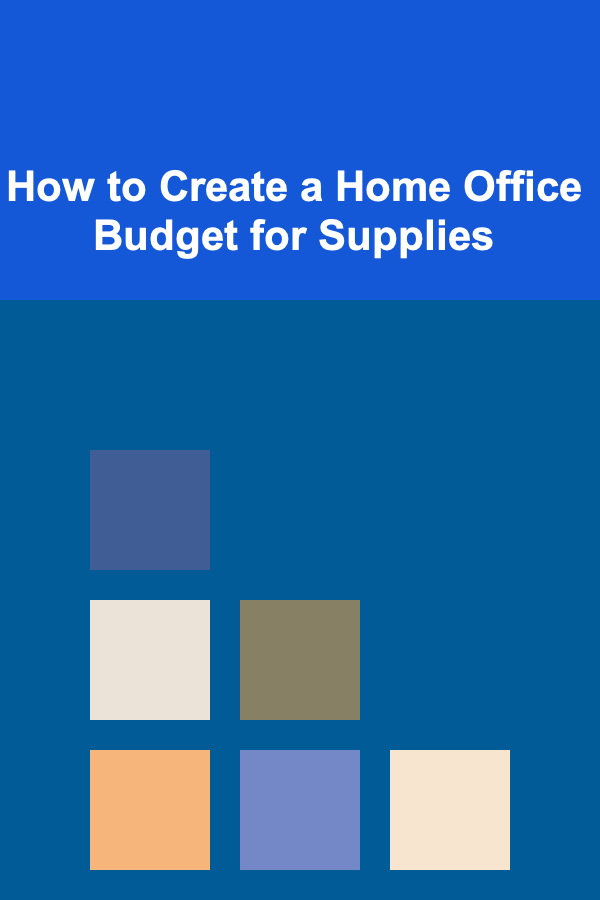
How to Track Home Insurance Deductibles and Discounts
ebook include PDF & Audio bundle (Micro Guide)
$12.99$9.99
Limited Time Offer! Order within the next:

Home insurance is an essential part of safeguarding your property, protecting your belongings, and ensuring peace of mind in the face of unexpected events like fires, theft, or natural disasters. One of the most important aspects of managing your home insurance is understanding and tracking the deductibles and discounts that can significantly affect your policy's cost.
In this article, we'll explore how to track home insurance deductibles and discounts effectively, how they impact your premiums, and strategies for maximizing your savings. We'll cover everything from the basic definitions of deductibles and discounts to practical tips for keeping track of these factors.
Understanding Home Insurance Deductibles
What is a Home Insurance Deductible?
A deductible is the amount of money you must pay out of pocket before your insurance company begins to cover the rest of your claim. In the context of home insurance, it's the portion of the claim you are responsible for when damage or loss occurs.
There are two main types of deductibles that affect home insurance policies:
- Fixed Deductible: A specific dollar amount, such as $1,000 or $2,500, that you must pay before your insurer covers the remaining costs.
- Percentage Deductible: A percentage of the insured value of your home. For example, if your home is valued at $200,000 and your deductible is 1%, you would need to pay $2,000 out of pocket before the insurance kicks in.
How Does the Deductible Affect Your Premium?
Generally, the higher your deductible, the lower your premium. This is because you're agreeing to take on more of the financial responsibility in the event of a claim. Conversely, a lower deductible means you'll pay a higher premium, but your out-of-pocket expenses will be less when filing a claim.
Tracking Your Deductible
To track your deductible:
- Review Your Policy: Your insurance policy will clearly state your deductible amount. This can usually be found in the declarations section of your policy document.
- Understand the Impact of Changes: If you adjust your deductible, it can have a direct impact on your premiums. Make sure to monitor these changes when renewing your policy or adjusting coverage.
- Set Reminders: Set reminders on your calendar or through an app to review your deductible periodically. This will help ensure that you're aware of its effect on your overall insurance costs.
Tracking Home Insurance Discounts
Insurance providers offer various discounts that can lower your premiums, and it's essential to track these discounts to ensure you're receiving the best deal possible. Some common discounts include:
1. Multi-Policy Discount
If you have more than one type of insurance with the same company, such as auto insurance and home insurance, you may qualify for a multi-policy discount. The more policies you bundle, the higher the discount may be.
Tracking Tips:
- Check your policy documents to see if you're eligible for a multi-policy discount.
- If you've added or removed policies, make sure the discount is applied to your premium.
2. Security System Discount
Insurance companies often offer discounts for homes equipped with security systems such as burglar alarms, smoke detectors, or surveillance cameras. These systems reduce the risk of damage or loss, so insurers are likely to offer a break on premiums.
Tracking Tips:
- Ensure that your insurance company is aware of any new security systems installed in your home.
- Keep a record of your home security system's installation date and updates.
3. Claims-Free Discount
If you haven't filed a claim for a specified period, you may be eligible for a claims-free discount. Insurers reward policyholders who maintain a good claims history by offering lower premiums.
Tracking Tips:
- Keep track of any claims made and the dates they occurred. If you've gone for several years without making a claim, it may be time to ask your insurer about potential discounts.
- Some insurers offer a "claims-free" discount after three to five years of no claims.
4. Home Improvements Discount
Upgrading certain aspects of your home, such as the roof, plumbing, electrical systems, or heating, can lead to discounts. These improvements reduce the risk of damage and may qualify you for premium reductions.
Tracking Tips:
- Document the home improvements you've made and notify your insurer of any changes that might reduce your risk.
- Keep receipts and before-and-after photos to support your case for a discount.
5. Loyalty Discount
Many insurers offer loyalty discounts to policyholders who renew their policies year after year with the same company. This discount is a reward for your continued business.
Tracking Tips:
- Review your renewal notices to check if the loyalty discount is being applied.
- Contact your insurance provider if you don't see this discount on your premium.
6. New Home Discount
If you recently purchased a new home, some insurers offer discounts as part of their marketing strategies. The assumption is that newer homes are less likely to experience issues like wear and tear, so insurers are willing to offer a break on premiums.
Tracking Tips:
- If you've moved recently, ask your insurer if they offer a new home discount.
- Keep proof of the home's age and condition to help negotiate better terms.
Strategies for Maximizing Savings on Home Insurance
Once you understand the different types of deductibles and discounts, it's time to think about how to maximize your savings. Here are several strategies to ensure you're getting the best possible deal on your home insurance policy.
1. Increase Your Deductible
One of the simplest ways to lower your premium is by increasing your deductible. If you're financially prepared to handle a larger out-of-pocket expense in the event of a claim, raising your deductible could save you money in the long term. However, always ensure that the increase in premium savings justifies the potential out-of-pocket cost.
2. Review Your Discounts Annually
Insurance discounts can change over time, especially as your home improves or your insurance needs evolve. To make sure you're getting the maximum savings:
- Review your policy each year to ensure all available discounts are applied.
- Don't be afraid to ask your insurance provider about any new discounts or promotions.
3. Shop Around and Compare Quotes
Just because you've been with the same insurer for years doesn't mean you're getting the best rate. Take the time to shop around and compare quotes from different providers to see if you can find a better deal. Use online tools or work with an insurance broker to get quotes from multiple insurers.
4. Keep Your Home in Good Condition
Regular maintenance can help prevent potential damage, which, in turn, may reduce your insurance premiums. A well-maintained home is less likely to file a claim, and some insurers may offer discounts for having a property that's in good condition.
5. Consider the Location of Your Home
Certain locations may come with a higher premium due to increased risks, such as flood-prone areas or regions with a higher incidence of theft. If you're in the process of moving or buying a new home, consider how location affects your insurance rates. In some cases, you may be able to adjust your policy to lower your premium by selecting a different location within the same city or region.
Using Technology to Track Your Home Insurance Deductibles and Discounts
In the digital age, technology can be a powerful ally in tracking your home insurance policy's details, including deductibles and discounts. Here are a few tools that can help:
1. Insurance Company Apps
Many insurance providers offer apps that allow you to manage your policy, track claims, and review your deductible and discounts. These apps often feature a dashboard that shows your policy details at a glance, making it easier to monitor your coverage and premiums.
2. Budgeting and Financial Apps
You can use budgeting apps like Mint or YNAB (You Need a Budget) to track your home insurance payments and premiums. These apps can alert you to changes in your expenses, which can be helpful when you're keeping track of deductible and discount adjustments.
3. Home Insurance Calculators
Many websites offer home insurance calculators that can help you estimate how changes to your deductible or coverage might impact your premium. These calculators can help you make informed decisions when adjusting your policy.
Conclusion
Tracking home insurance deductibles and discounts is a critical part of managing your policy and ensuring that you're paying the right amount for the coverage you need. By understanding your deductible, regularly reviewing your policy for available discounts, and using technology to stay organized, you can maximize your savings and ensure you're getting the best value from your home insurance provider.
Keep in mind that home insurance is not a one-size-fits-all product, and what works for one homeowner might not work for another. Regularly assess your needs, track your policy details, and make adjustments as necessary to ensure you're not paying more than you need to.
Reading More From Our Other Websites
- [Home Party Planning 101] How to Organize a Super Bowl Party: What Are the Top Food and Decor Tips?
- [Home Cleaning 101] How to Remove Dust from Your Houseplants
- [Home Cleaning 101] How to Clean Your Home with Baking Soda and Vinegar
- [Home Storage Solution 101] How to Style Your Home with Wicker Baskets: Functional Storage with a Rustic Touch
- [Home Lighting 101] How to Choose the Best Lighting for Your Home Office
- [Organization Tip 101] How to Turn Meal Prep into Family Bonding Time
- [Home Soundproofing 101] How to Soundproof Your Fireplace for a Quieter Home
- [Organization Tip 101] How to Create a Scrapbook for Your DIY Inspirations
- [Home Party Planning 101] How to Feed a Crowd Without Breaking the Bank: Budget-Friendly Party Food Ideas
- [Home Security 101] How to Secure Your Home on a Budget

How to Communicate Effectively with Instructors Online
Read More
How to Create a Home Office Budget for Supplies
Read More
How to Organize Your Child's School Supplies Effectively
Read More
How to Understand Lighting and Shadows in Art
Read More
How To Play the Lute: Renaissance Music
Read More
How to Choose Wine for Holiday Gatherings
Read MoreOther Products

How to Communicate Effectively with Instructors Online
Read More
How to Create a Home Office Budget for Supplies
Read More
How to Organize Your Child's School Supplies Effectively
Read More
How to Understand Lighting and Shadows in Art
Read More
How To Play the Lute: Renaissance Music
Read More